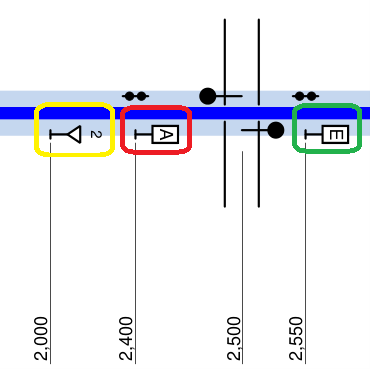The printable version is no longer supported and may have rendering errors. Please update your browser bookmarks and please use the default browser print function instead.
Introduction
Documentation
Syntax
Autoexport from the XML-Schema for element IS:isSpeedSignal of railML ® version 3.2 |
| Documentation
|
use this child element to specify the speed signal in more detail
|
| Subschema
|
infrastructure
|
| Parents*
|
signalIS
|
| Children
|
refersToBeginOfSpeedSection (0..*), refersToEndOfSpeedSection (0..*)
|
Attributes:
- trainRelation: DEPRECATED, please use speedSection@refersToTrain instead;
Reference to the part of the train from where on the shown speed signal aspect is valid. Normally, a limiting speed signal aspect relates to the head of the train while a speed release refers to the end of the train. (optional; xs:string)
- Possible values:
- endOfTrain: The tail of the train should be located at the stopping place when the train has stopped.
- headOfTrain: The headof the train should be located at the stopping place when the train has stopped. This is the default setting.
- midOfTrain: The center of the train should be located at the stopping place when the train has stopped.,
- type: speed signal/panel type (announcement, execution) (optional;
xs:string)
- Possible values:
- announcement: announcing a change of allowed speed
- execution: marking begin of section with changed allowed speed
|
*Notice:
Elements may have different parent elements. As a consequence they may be used in different contexts.
Please, consider this as well as a user of this wiki as when developing this documentation further.
Aspects that are only relevant with respect to one of several parents should be explained exclusively in the documentation of the respective parent element.
|
Autoexport from the XML-Schema for element IS:isSpeedSignal of railML ® version 3.1 |
| Documentation
|
use this child element to specify the speed signal in more detail
|
| Subschema
|
infrastructure
|
| Parents*
|
signalIS
|
| Children
|
any (0..*), refersToBeginOfSpeedSection (0..*), refersToEndOfSpeedSection (0..*)
|
Attributes:
- type: speed signal/panel type (announcement, execution) (optional;
xs:string)
- Possible values:
- execution: marking begin of section with changed allowed speed
- announcement: announcing a change of allowed speed,
- trainRelation: Reference to the part of the train from where on the shown speed signal aspect is valid. Normally, a limiting speed signal aspect relates to the head of the train while a speed release refers to the end of the train. (optional;
xs:string)
- Possible values:
- endOfTrain
- midOfTrain
- headOfTrain
|
*Notice:
Elements may have different parent elements. As a consequence they may be used in different contexts.
Please, consider this as well as a user of this wiki as when developing this documentation further.
Aspects that are only relevant with respect to one of several parents should be explained exclusively in the documentation of the respective parent element.
|
Changes 3.1→3.2
The children have changed.
The attributes have been changed.
Semantics
Best Practice / Examples
The modelling of a temporary speed restriction by railML 3.2 infrastructure subschema is as follows. In Germany, for this, three signals are used (figure 1): announcement, indication and ending. The following signals are used for this:
1. Announcement of temporary speed restriction (yellow one)
2. begin of temporary speed restriction (red one)
3. end of temporary speed restriction (green one)

Figure 1 Temporary speed restriction signalization in Germany
Let’s now decompose each of them aspect by aspect.
“Announcement of temporary speed restriction” can be decomposed and modelled the following way:
• Announcement speed restriction ‒ <signal>, <isSpeedSignal> @type = announcement, <refersToBeginOfSpeedSection>
• Temporary ‒ according to [1] <isValid> is used to mark a start and end days.
“begin of temporary speed restriction” can be decomposed and modelled the following way:
• begin speed restriction ‒ <signal>, <isSpeedSignal> @type = execution, <refersToBeginOfSpeedSection>
• Temporary ‒ according to [1] <isValid> is used to mark a start and end days.
“end of temporary speed restriction” can be decomposed and modelled the following way:
• end speed restriction ‒ <signal>, <isSpeedSignal> @type = execution, <refersToEndOfSpeedSection>
• Temporary ‒ according to [1] <isValid> is used to mark a start and end days.
[1] https://documents.railml.org/schemas/usecase/railml-use-case_is-nest.pdf
Additional Information
Notes
Open Issues
